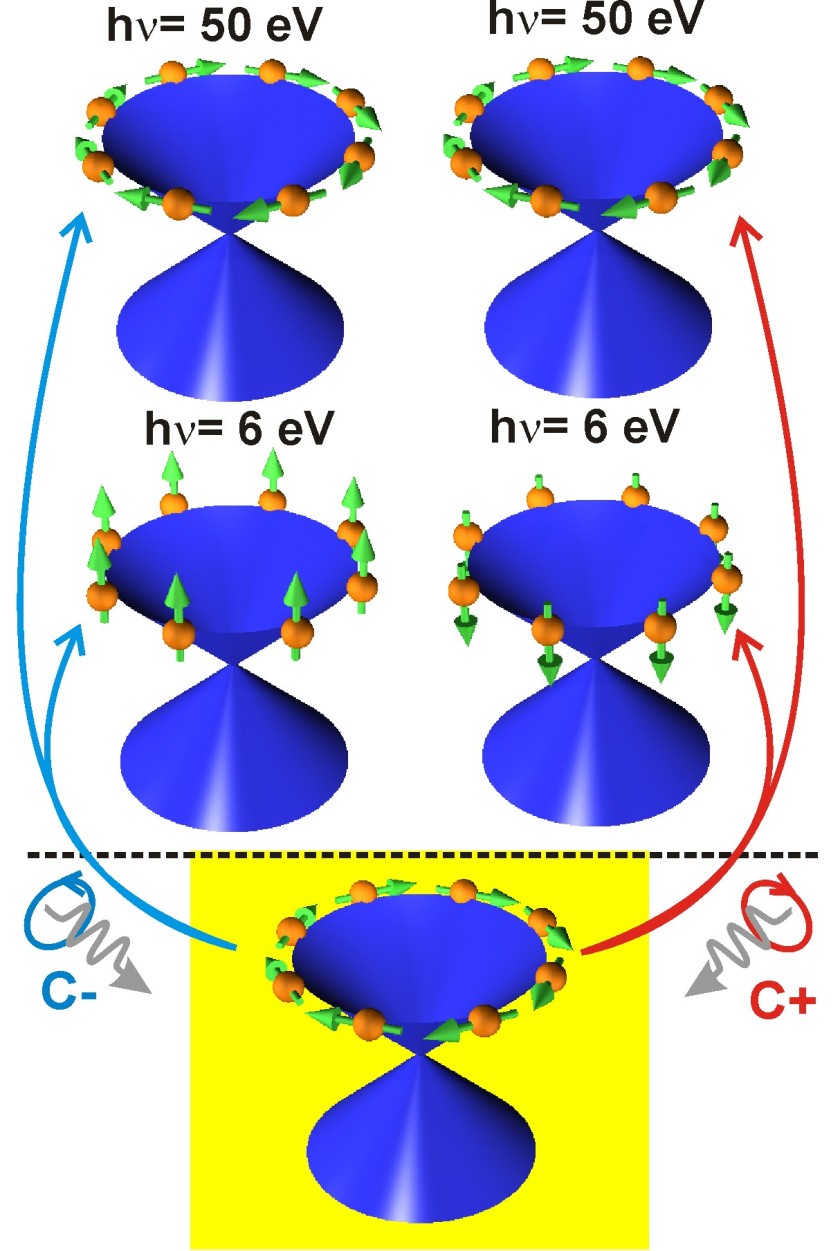How to use light to manipulate the spin in topological insulators

The picture shows the characteristic spin texture (arrows) in a topological insulator and how it is manipulated by circularly polarized light. © Rader/Sachez-Barriga/HZB
Researchers at HZB investigated the topological insulator bismuth selenide (Bi2Se3) by spin-resolved photoelectron spectroscopy at BESSY II. They found an astonishing difference depending on whether it is illuminated by circularly polarized light in the vacuum ultraviolet (50 electron volts, eV) and in the ultraviolet spectral range (6 eV). This result could help explaining how spin currents can be generated in topological insulators.
In the former case, the emitted electrons display the characteristic spin texture of topological insulators, which is aligned on a circle in the surface plane, similarly to a roundabout road sign. In the latter case, however, the spins do not only rotate completely out of this plane but also take on the spin direction imposed by the right or left circularly polarized light.
HZB researchers expect that this manipulation of the electron spin by light and the insight into its preconditions will be most useful for the generation of lossless spin currents in topological insulators.
Topological insulators are a novel state of matter with an insulating bulk and a metallic surface, which are interesting candidates for novel devices in future information technologies. Light-induced spin manipulation is one of the processes involved.The present work reveals the conditions for the generation of dissipationless spin currents in topological insulators.
Their results have just been accepted for publication in Physical Review X, the new top journal of the Americal Physical Society.
OR
https://www.helmholtz-berlin.de/pubbin/news_seite?nid=13928;sprache=en
- Copy link
-
Breakthrough at HZB: First electron beam in SEALab advances accelerator physics
The SEALab team at HZB has achieved a world first by generating an electron beam from a multi-alkali (Na-K-Sb) photocathode and accelerating it to relativistic energies in a superconducting radiofrequency accelerator (SRF photoinjector). This is a real breakthrough and opens up new options for accelerator physics.
-
Catalysis research with the X-ray microscope at BESSY II
Contrary to what we learned at school, some catalysts do change during the reaction: for example, certain electrocatalysts can change their structure and composition during the reaction when an electric field is applied. The X-ray microscope TXM at BESSY II in Berlin is a unique tool for studying such changes in detail. The results help to develop innovative catalysts for a wide range of applications. One example was recently published in Nature Materials. It involved the synthesis of ammonia from waste nitrates.
-
BESSY II: Magnetic ‘microflowers’ enhance magnetic fields locally
A flower-shaped structure only a few micrometres in size made of a nickel-iron alloy can concentrate and locally enhance magnetic fields. The size of the effect can be controlled by varying the geometry and number of 'petals'. This magnetic metamaterial developed by Dr Anna Palau's group at the Institut de Ciencia de Materials de Barcelona (ICMAB) in collaboration with her partners of the CHIST-ERA MetaMagIC project, has now been studied at BESSY II in collaboration with Dr Sergio Valencia. Such a device can be used to increase the sensitivity of magnetic sensors, to reduce the energy required for creating local magnetic fields, but also, at the PEEM experimental station, to study samples under much higher magnetic fields than currently possible.
